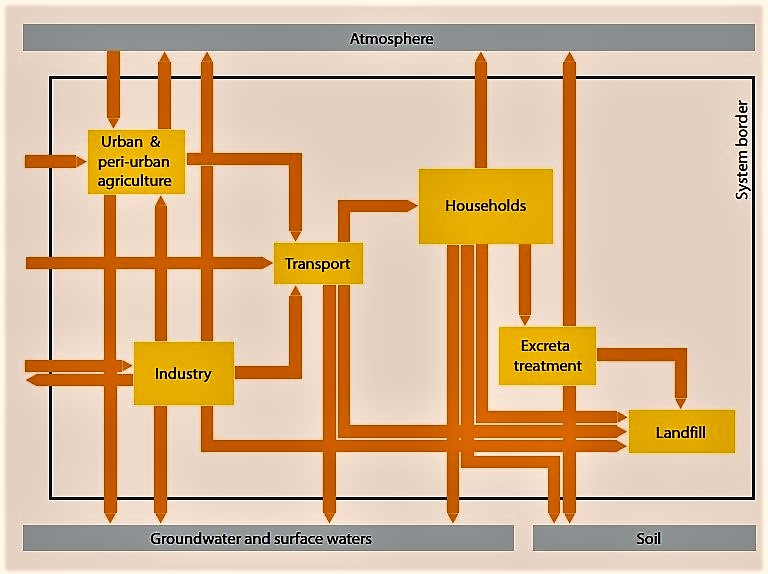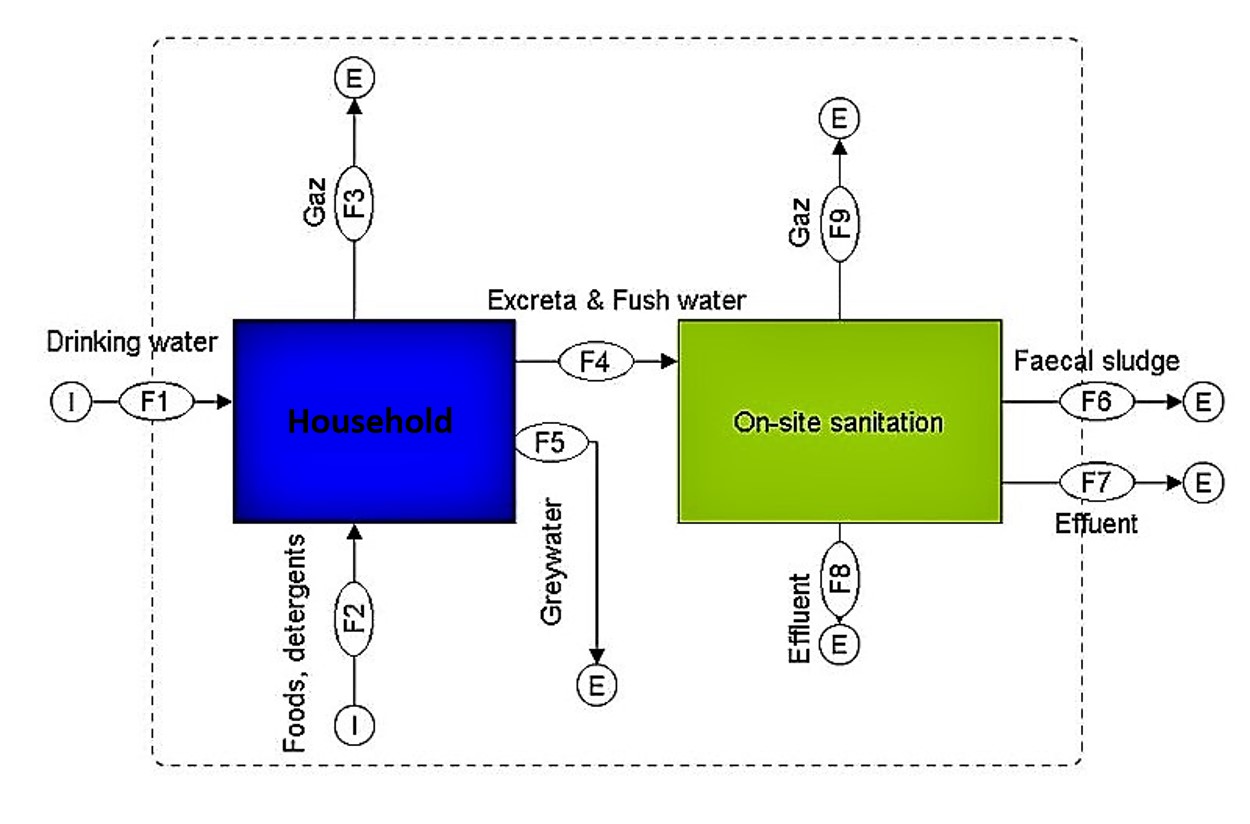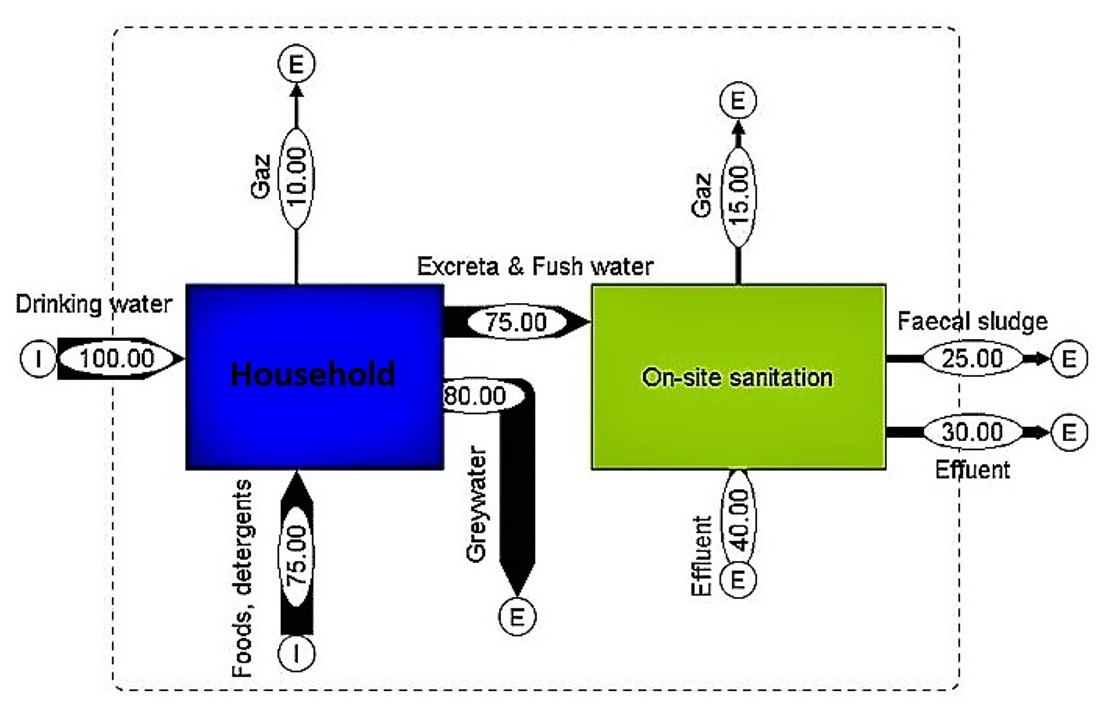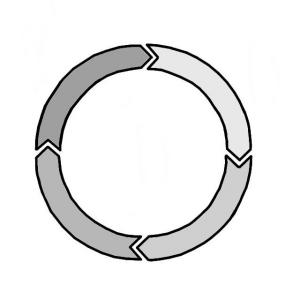Executive Summary
Material Flow Analysis (MFA) is the quantification and assessment of matter (water, food, excreta, wastewater...) and substances (nitrogen, phosphorus, carbon...) mass flows and processes, in a system (city, country, etc.) during a defined period. The principle of MFA is based on the law of matter conservation; flows are expressed in kg/year or in kg/capita/year. The method allows identifying problems and quantifying the impact of potential measures on resource recovery and environmental pollution. It can be used to compare different sanitation technology options regarding their environmental and financial impacts in order to support decision-making for choosing within different sanitation options.
What Is the Material Flow Analysis (MFA)?
The material flow analysis (MFA) method is described in the “Practical Handbook of Material Flow Analysis” by BRUNNER & RECHBERGER (2004). Material flow analysis contains the following main steps:
- Identification of the key (material flow related) issues.
- System analysis (selection of the relevant matter, processes, indicator substances (elements), and system boundaries).
- Quantification of mass flows of matter and indicator substances.
- Identification of weak points in the system.
- Development and evaluation of scenarios and schematic representation, interpretation of the results.
“Indicator substances”considered for MFA are generally chemical elements such as nitrogen (N) and phosphorus (P), carbon (C) or CO2 and NH3. These substances can be either pollutants (e.g. eutrophication) or resources (e.g. fertiliser in agriculture).
“Goods”represent a substance or a mixture of substances with a function valued by man such as food, solid waste and wastewater.
“Processes” describe the transformation, transport or storage of “goods” and “substances” such as households, wastewater treatment plants or agricultural soils.

How to Do a MFA?
The first and second step of MFA consists in the identification of the key material flows and the setting of system boundaries (selection of the relevant matter, processes, indicator substances). For the indicator substance nitrogen, for example, the relevant “goods” are the inputs and outputs to and from the household, which contain nitrogen: that implies food, excreta, blackwater, greywater and organic solid waste. In order to have an overview of nitrogen pathways at household level, the processes are the household (food and water consumption, digestion, and kitchen wastes) and the on-site sanitation system. Nitrogen containing “goods” are being transformed in these two processes. For example, nitrogen enters the human organism as food (household) and leaves it, after digestion, with the excreta (on-site sanitation system). The system boundaries includes all household activities and the on-site sanitation system.

The third step consists in quantifying “goods” and substance flows in the system. Only the substance-flows (nitrogen-flows in this example) are of interest in this case. “Substance” flows are often calculated based on the mass flows of “goods” and substance concentrations in these “goods”. For example, the nitrogen flow in excreta can be assessed by multiplying the quantity of excreta produced per capita per day with the nitrogen concentration in excreta. Source data can be obtained from literature, estimations, measurements or calculations.
In the fourth and fifth step, the assessed “good” and/or substance flows are represented graphically and interpreted (see picture below). The software STAN (Software for Substance Flow Analysis), which is open source can be used for graphic representation. STAN was developed by the Vienna University of Technology and can be downloaded on the internet for free. It can be used as a base for modelling material flows for the assessment of the economic resources and environmental values of materials (CENCIC & RECHBERGER 2008). The Vienna University of Technology also offers workshops on the use of MFA and STAN; you can subscribe to their newsletter to stay informed.

Subscribe here to the new Sanitation and Water Entrepreneurship Pact (SWEP) newsletter. SWEP is a network of organizations joining hands to help entrepreneurs design and develop lasting water and sanitation businesses.
Combating Lack of Data with Expert Judgements
Because of the amount of data needed, the implementation of MFA is difficult in the contexts of developing countries. MONTANGERO (2006) suggested therefore using the method of “eliciting expert judgement” to deal with this problem. Eliciting expert judgement consists in the translation of expert knowledge (subjective judgements) into probabilities for real values (data). Eliciting expert judgement comprises seven steps, the first step consists in the identification of the parameters for which expert assessment is needed; the second step consists in the recruitment of experts; followed by motivating experts; the development of a general model that reflects the experts’ thinking; the training of the experts in probability assessment; the required probability assessments and a documentation of the reasoning behind the assessments; and finally the aggregation of experts’ probability distributions (i.e. if experts’ views on the same parameter differ, it is important to try to understand why they reach different conclusions). Additional knowledge subsequently gained through measurements for example can be combined with expert knowledge.
MFA can be used for environmental impact assessments, development of environmental policy for hazardous substances, nutrient management in watersheds, waste management and for sanitation planning.
MFA allows gaining a critical view on resource management including excreta, faecal sludge, wastewater and kitchen waste management and nutrient and water requirements in a city or a country. It is applicable for evaluating the environmental soundness of sanitation options by calculating and comparing the quantity of nitrogen or phosphorus flows within the city for each sanitation technology options. In this way, decision makers can choose the best options which do not pollute groundwater surface water and allow nutrient recycling.
Material flow analysis: a planning tool for organic waste management in Kumasi, Ghana
Regional water balance as a tool for water management in developing countries
Practical Handbook of Material Flow Analysis. Advanced Methods in Resource and Waste Management
Material flow analysis with Software STAN
This paper explains how to use the Stan Software for the graphic representation of material flows under consideration of data uncertainties.
CENCIC, O. ; RECHBERGER, H. (2008): Material flow analysis with Software STAN. In: Journal of Environmental Engineering and Management: Volume 18 , 3-7.Linking Urban Agriculture and Environmental Sanitation
The poster presents material flow analysis as a method to assess the material and nutrient flows in a given system and thus to link urban agriculture and environmental sanitation: The case of Kumasi, Ghana.
FORSTER, D. SCHERTENLEIB, R. BELEVI, H. (2003): Linking Urban Agriculture and Environmental Sanitation. Duebendorf: Swiss Federal Institute for Environmental Science (EAWAG) URL [Accessed: 10.04.2019]Establishing Phosphorus Fluxes Through Material Flow Accounting and Systems Thinking in an Urban Shed in Harare, Zimbabwe
Phosphorus (P) resources globally are considered limited. P originates from a mined non-renewable rock, therefore its presence in the urban-shed demonstrates the impact of urbanisation and the anthropogenic influences on natural cycles of material flow. Any recycling of P is therefore becoming increasingly important. In passing through the linear urban system P is mobilised from particulate to soluble forms. With the present level of nutrient losses from urban water management into the aquatic environment (leading to adverse health and ecological impacts) commitment to urban or peri-urban ecological agriculture (without synthetic fertilisers) offers an attractive solution to the management of urban organic “wastes”.
GUMBO, B. (1999): Establishing Phosphorus Fluxes Through Material Flow Accounting and Systems Thinking in an Urban Shed in Harare, Zimbabwe. Harare: SSRZ Seminar II URL [Accessed: 10.04.2019]Identification of pollution source of cadmium in soil: Application of material flow analysis and a case study in Taiwan
Material Flow Analysis for Environment Sanitation Planning in Developing Countries: an approach to assess material flows with limited data availability
Assessing nutrient flows in septic tanks by eliciting expert judgement: A promising method in the context of developing countries
The method of material flow analysis, a tool for selecting sustainable sanitation technology options: The case of Pouytenga (Burkina Faso)
Material flow analysis with Software STAN
This paper explains how to use the Stan Software for the graphic representation of material flows under consideration of data uncertainties.
CENCIC, O. ; RECHBERGER, H. (2008): Material flow analysis with Software STAN. In: Journal of Environmental Engineering and Management: Volume 18 , 3-7.Building the Concept of Material Flow Analysis into the Household- Centred Environmental Sanitation Planning Approach
The paper discusses very first ideas how the method of material flow analysis could be integrated in the Household-Centred Environmental Sanitation Planning Approach.
MONTANGERO, A. ANH, N. V. LUETHI, C. SCHERTENLEIB, R. BELEVI, H. (2006): Building the Concept of Material Flow Analysis into the Household- Centred Environmental Sanitation Planning Approach. Conference of Renewed Efforts to Plan for Sustainable Development. European Academy for the Urban Environment and Technical University Berlin, Germany URL [Accessed: 18.10.2010]Modelling sanitation scenarios in developing countries: a case study in Kumassi, Ghana
This document explains how a model-based on material flow analysis (MFA) and life cycle assessment (LCA) was constructed to evaluate the environmental performance of the scenarios. The variables were nitrogen, phosphorus and organic carbon. The evaluation focused on eutrophication and potential reuse of nutrients in agriculture.
DAHLMAN. K (2009): Modelling sanitation scenarios in developing countries: a case study in Kumassi, Ghana. Sweden: Uppsala University URL [Accessed: 10.04.2019]Material Flow Analysis – A Tool for Nutrient Resource Management
This paper shows a case study in Vietnam where a material flow analysis is applied in a rural area.
DO-THU, N. ; MOREL, A. ; PHAM-DUC, P. ; NGUYEN-VIET, H. ; KOOTATTEP, T. (2010): Material Flow Analysis – A Tool for Nutrient Resource Management. In: Sandec news : Volume 11 , 28. URL [Accessed: 18.10.2010]Evaluating the impacts of sanitation options on urban water quality by using the Material Flow Analysis method: case of Fada N’Gourma, Burkina Faso
This paper describes how the material flow analysis can be used as a tool to evaluate the environmental friendliness of sanitation options in a middle size city in Burkina Faso.
KOANDA, H. GALIERE, P. YIOUGO, L. WETHE, J. (2010): Evaluating the impacts of sanitation options on urban water quality by using the Material Flow Analysis method: case of Fada N’Gourma, Burkina Faso. Stockholm, Sweden: Stockholm Water Week URL [Accessed: 30.10.2010]Optimising Environmental Sanitation in Yopougon, Coete Ivoire
This document highlights how the material flow analysis method can be use to analyse N and P flows in a district of Abidjan in Côte d’Ivoire in order to develop sustainable sanitation options for wastewater management.
KOFFI, P.K. ; DONGO, K. ; NGUYEN-VIET, H. ; CISSE, G. (2010): Optimising Environmental Sanitation in Yopougon, Coete Ivoire. In: Sandec news : Volume 11 , 28. URL [Accessed: 18.10.2010]Assessment of Water Quality Problems and Mitigation Potentials by using Material Flow Analysis - A case study In the Tha Chin River Basin, Thailand
The paper presents the methodological approach of material flow analysis, as it is used in the specific context of assessing nutrient pollution problems in a tropical, lowland river system, on the basis of scarce and uncertain data.
SCHAFFNER, M. KOOTTATEP, T. SCHERTENLEIB, R. (2005): Assessment of Water Quality Problems and Mitigation Potentials by using Material Flow Analysis - A case study In the Tha Chin River Basin, Thailand. Ubon Ratchathani, Thailand: Role of Water Sciences in Transboundary River Basin Management URL [Accessed: 18.10.2010]Material Flux Analysis for Planning of Domestic Solid Waste and Wastewater Management: A Case Study in Pak Kret Municipality, Nonthaburi, Thailand
This publication describes problems as well as potential solutions in the field of environmental sanitation based on the analysis of nitrogen flows in the city of Pak Kret, Thailand.
THITIPHON, S. THAMMARAT, K. MONTANGERO, A. (2005): Material Flux Analysis for Planning of Domestic Solid Waste and Wastewater Management: A Case Study in Pak Kret Municipality, Nonthaburi, Thailand. Thailand: URL [Accessed: 18.10.2010]Linking Urban Agriculture and Environmental Sanitation
The poster presents material flow analysis as a method to assess the material and nutrient flows in a given system and thus to link urban agriculture and environmental sanitation: The case of Kumasi, Ghana.
FORSTER, D. SCHERTENLEIB, R. BELEVI, H. (2003): Linking Urban Agriculture and Environmental Sanitation. Duebendorf: Swiss Federal Institute for Environmental Science (EAWAG) URL [Accessed: 10.04.2019]STAN (subSTance flow ANalysis) software
STAN software for the graphic representation of material flows can be downloaded for free on this homepage.
Siedlungshygiene und Wasser für Entwicklung
This website contains some case studies of material flow analyses in developing countries.


